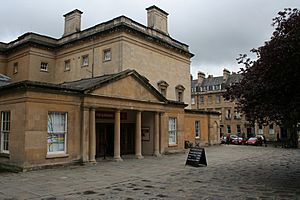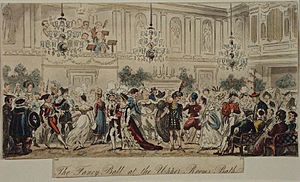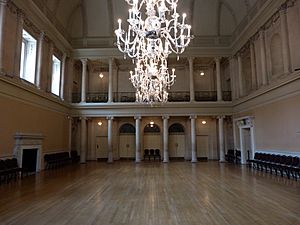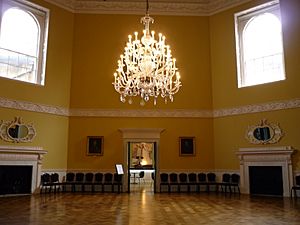Bath Assembly Rooms facts for kids
Quick facts for kids Assembly Rooms |
|
|---|---|

The Assembly Rooms and Fashion Museum
|
|
| Location | Bath, England |
| Built | 1771 |
| Restored | 1963 |
| Restored by | Sir Albert Richardson |
| Architect | John Wood, the Younger |
| Architectural style(s) | Georgian |
| Governing body | Bath and North East Somerset Council |
| Owner | National Trust |
|
Listed Building – Grade I
|
|
| Official name: Assembly Rooms | |
| Designated | 12 June 1950 |
| Reference no. | 1394144 |
| Lua error in Module:Location_map at line 420: attempt to index field 'wikibase' (a nil value). | |
The Bath Assembly Rooms are a beautiful historic building in Bath, England. They were designed by an architect named John Wood the Younger in 1769. These rooms were once the most popular place for fancy parties, concerts, and social gatherings during the Georgian era.
Today, the Assembly Rooms are open to the public. They are considered a Grade I listed building, which means they are very important and protected. The building is owned by the National Trust and managed by the local council. You can even find the Fashion Museum in its basement!
Contents
What are the Bath Assembly Rooms?
The Bath Assembly Rooms are a group of large, elegant rooms built for people to meet and have fun. In the 1700s, Bath was a very popular city for wealthy people to visit. They came for the natural hot springs and to socialize. The city needed a grand place for balls (dances), music concerts, and card games.
The Assembly Rooms opened in 1771 with a huge ball. They quickly became the center of social life in Bath. Famous writers like Jane Austen and Charles Dickens visited them. Even kings and queens of the time would have spent time here!
The building is made of a creamy stone called Bath stone. It has four main rooms: a huge ballroom, a tea room, a card room, and an octagon-shaped room. These rooms are decorated with beautiful chandeliers and artworks.
In the 1900s, the rooms were even used as a cinema for a while. Sadly, they were badly damaged during World War II when bombs hit Bath. But they were carefully rebuilt and reopened in 1963.
A Look Back: History of the Rooms
Bath became a very fashionable place during the Georgian era (the time when kings named George ruled Britain). Many visitors came to enjoy the spa and resort town. To make space for everyone, architects like John Wood the Elder and his son, John Wood the Younger, designed new parts of the city. They created grand streets and squares with impressive buildings. Much of the stone used came from nearby mines.
The younger John Wood designed the famous Royal Crescent, a curved row of beautiful houses. But he also needed a place for people to gather indoors. Another architect, Robert Adam, suggested a design for the Assembly Rooms, but it was too expensive.
So, John Wood the Younger found a clever way to raise money. He used something called a tontine. This was a special investment plan where people put money into a fund. They would then receive payments from the fund. As people passed away, their share would go to the remaining investors, making their payments bigger. The last person alive would get everything! This plan helped fund the building, and construction began in 1769. The rooms were finished and opened in 1771.
The Assembly Rooms were often called the "Upper Rooms" because there was an older, smaller assembly room in the city. But the new, grand Upper Rooms quickly became the most popular spot.
Social Life and Famous Visitors
People would gather at the Assembly Rooms in the evenings for dances, concerts, and card games. It was a place where young ladies hoping to find a husband would meet eligible men. Imagine a huge party with 800 people, including 60 members of the royal family and nobles! During the social season (October to June), there were at least two balls every week, plus many concerts.

The famous writer Jane Austen lived in Bath for a few years. She wrote about the Assembly Rooms in her novels, Northanger Abbey and Persuasion. Here's a small part from Northanger Abbey:
Mrs Allen was so long in dressing, that they did not enter the ball-room till late. The season was full, the room crowded, and the two ladies squeezed in as well as they could. As for Mr Allen, he repaired directly to the card-room, and left them to enjoy a mob by themselves.
Charles Dickens, another famous writer, also visited Bath and gave readings in the Assembly Rooms. He mentioned them in his book, The Pickwick Papers:
In the ball-room, the long card-room, the octagonal card-room, the staircases, and the passages, the hum of many voices, and the sound of many feet, were perfectly bewildering. Dresses rustled, feathers waved, lights shone, and jewels sparkled. There was the music — not of the quadrille band, for it had not yet commenced; but the music of soft tiny footsteps, with now and then a clear merry laugh — low and gentle, but very pleasant to hear in a female voice, whether in Bath or elsewhere.
Many talented musicians performed here too. A young violinist named George Bridgetower made his first public appearance here in 1789.
Changes in the 20th Century
In the 1900s, the Assembly Rooms saw many changes. The Ballroom even became a cinema for a while! In 1931, a group called the Society for the Protection of Ancient Buildings took over the building and began to restore it.
However, during World War II, Bath was bombed in what was known as the Baedeker Blitz. On April 25-26, 1942, the Assembly Rooms were hit and burned inside. It was a terrible loss. After the war ended, the rooms were rebuilt by Sir Albert Richardson. The restoration work was finished in 1963, bringing the grand building back to life.
Inside the Assembly Rooms: Architecture
The Assembly Rooms are built from limestone and have a special type of roof called a hipped roof. The building is shaped like a "U" inside. It has a grand entrance with Doric columns.
The main rooms are:
- The Ballroom: This is the largest room, over 100 feet (30 meters) long and nearly 45 feet (14 meters) wide. It has a very high ceiling, 42 feet (13 meters) tall! Five beautiful Whitefriars crystal chandeliers hang from the ceiling. Up to 500 people can fit in this room.
- The Tea Room: This room is 60 feet (18 meters) long and 42 feet (13 meters) wide. It can hold up to 250 people. It was once the place where people would enjoy tea and snacks.
- The Octagon Room: This room is named for its eight-sided shape. It's 42 feet (13 meters) across and has four fireplaces to keep it warm. It used to have an organ for music.
- The Card Room: This room was added in 1777 and was where people played card games. Today, it's often used as a bar during events.
All the rooms are decorated with paintings by famous artists like Thomas Gainsborough and Allan Ramsay (artist).
The Assembly Rooms Today
Today, the National Trust owns the Bath Assembly Rooms, and the Bath and North East Somerset Council manages them. The main rooms are still used for special events, like private parties and concerts. They are also a key venue for the Bath International Music Festival.
In the basement of the building, you'll find the amazing Fashion Museum. This museum has a huge collection of clothes, with over 30,000 items! It shows how fashion has changed for men, women, and children from the late 1500s right up to today. You can see everything from old embroidered shirts to modern outfits.
Because of their beautiful Georgian style, the Assembly Rooms are often used as a filming location. They have appeared in movies and TV shows set in the Georgian period, including adaptations of Jane Austen's novels like Northanger Abbey and Persuasion.



